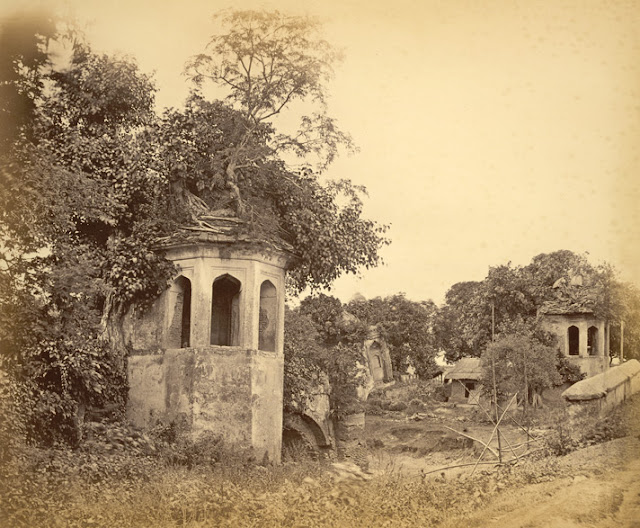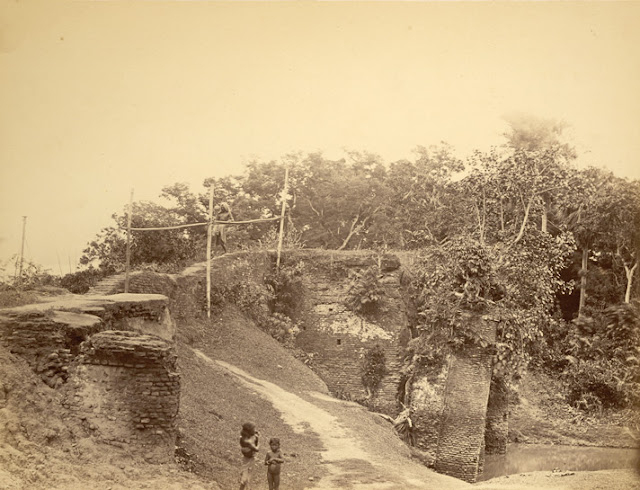 |
A lane in Sonargaon towards Panama, 1870’s Sonargaon
A lane in Sonargaon towards Panama, 1870’s Sonargaon Photograph of a lane in Sonargaon towards Panam. This print was taken by an unknown photographer in the 1870s and is one of a series of 88 albumen prints in an album entitled 'Views in India and Bangladesh', part of the Temple Collection. The view shows a narrow path through a wood near Sonargaon in Bangladesh. |
 |
Old Goaldih Mosque, known as the Puarana Masjid, 1872’s Sonargaon
Old Goaldih Mosque, known as the Puarana Masjid, 1872’s Sonargaon Photograph of the Goaldih Mosque, known as the Puarana Masjid, Sonargaon in Bangladesh, from the Archaeological Survey of India Collections, taken by W.Brennand in 1872. This is a general view of the mosque at Sonargaon, in a very ruinous state and largely covered by vegetation. The mosque is described in J. Wise, Notes on Sunargaon, Eastern Bengal (Journal of the Asiatic Society of Bengal, vol. XLIII, part I, Calcutta, 1874), p. 92: 'About a hundred yards to the south [of Abdul Hamid's Mosque] is the oldest mosque in Sonargaon. The residents call it the purana, or old, Goaldih mosque. Its kitabah had fallen out, but had been carefully preserved in the interior. On this stone is inscribed the name of 'Ala-uddin Husain Shah, A.H. 925 (A.D. 1519)'. |
 |
Cemetery, Narind, 1870’s Dhaka
Cemetery, Narind, 1870’s Dhaka Photograph taken by an unknown photographer in the 1870s of the Christian Cemetery at Narind in Dhaka, the capital of Bangladesh. The view shows the arched Mughal style gateway to the cemetery on the left and on the right is an elaborate tomb built in the Indo-Gothic style with its pointed archway doors and jali screen windows. |
 |
Fac Simile of an Inscription in the Great Kuttra, 1055’s Dhaka
Face Simile of an Inscription in the Great Kuttra, 1055’s Dhaka This inscription is written in Persian on the walls of the Bara (Great) Katra in Dhaka. It explains that Abu'l-Qasim Tabataba Shuja Husayni Al-Simmani erected the building and the 22 adjoining shops. The profits from these shops would to go towards the cost of repairing the Bara Katra and also provide either free shelter or a caravanserai for travellers and merchants. These conditions were not to be violated or punishment would be forthcoming on the Day of Judgement. The inscription was written in 1055 An Hegira (1645AD) by Su'd al-Din Muhammad Shirazi. This engraving was based on a drawing by James Atkinson, which served as plate 7 in Charles D'Oyly's 'Antiquities of Dacca'. |
 |
Ruins of Pagla Pul/Bridge: 5 miles from Dhaka, 1870’s Dhaka
Ruins of Pagla Pul/Bridge: 5 miles from Dhaka, 1870’s Dhaka
Photograph of the ruined bridge at Paglarpul taken in the 1870s by an unknown photographer. This famous bridge was built in the 17th century when Dhaka was a seat of Mughal Government. The area has a hot, damp tropical climate and is flooded periodically by waters from the Bay of Bengal as well as from the yearly moonsoon. By the 19th century many of the once-elegant buildings in the city were ruined by the action of both the climate and the resultant wildly luxuriant overgrowth of trees and vegetation which lent them a picturesque look and made them popular subjects for artists and photographers.
|
 |
View looking over a bridge, 1870’s Sonargaon
View looking over a bridge, 1870’s Sonargaon
This print from the Temple Collection was taken by an unknown photographer in the 1870s. Sonargaon is situated in the Dhaka District, Bangladesh near the banks of the Meghna, 15 miles east of Dacca. It was the ancient Muhammadan capital of Eastern Bengal. However, only the ruins of the ancient city of Sonargaon remain and the area is buried in a dense jungle of bamboos and other trees. Waterways were traditionally the most important means of communication in Dacca and when the rivers rise, the whole of the lower part of the district floods and boats were practically the only means of transport for men and goods.
|
 |
View though the central arch of a bridge over a canal, 1870’s Sonargaon
View though the central arch of a bridge over a canal, 1870’s Sonargaon Photograph of a view through the central arch of a bridge over a canal in Sonargaon. This print from the Temple Collection was taken by an unknown photographer in the 1870s. Sonargaon is situated in the Dhaka District, Bangladesh near the banks of the Meghna, 15 miles east of Dacca. It was the ancient Muhammadan capital of Eastern Bengal. However, only the ruins of the ancient city of Sonargaon remain; the area is buried in a dense jungle of bamboos and other trees. Waterways were traditionally the most important means of communication in Dacca and when the rivers rise, the whole of the lower part of the district floods and boats were practically the only means of transport for men and goods. |
All Posts
-
▼
2011
(64)
-
▼
March
(14)
-
▼
Mar 01
(14)
- A lane in Sonargaon towards Panama, 1870’s Sonargaon
- Old Goaldih Mosque, known as the Puarana Masjid, 1...
- Cemetery, Narind, 1870’s Dhaka
- Fac Simile of an Inscription in the Great Kuttra, ...
- Ruins of Pagla Pul/Bridge: 5 miles from Dhaka, 187...
- View looking over a bridge, 1870’s Sonargaon
- View though the central arch of a bridge over a ca...
- Panama City road, 1870’s Sonargaon
- The Company’s kut'hi (the East India Company facto...
- Old bridge, called Dullalpur pul, Panama, 1872’s S...
- New Goaldih Mosque, known as Abdul Hamid's Masjid,...
- Ramna Gate to Race Course (now Subrawardy Udyan), ...
- Mill buildings, Gandharia, 1870’s Dhaka
- Christian cemetery, Narinda, 1870’s Dhaka





